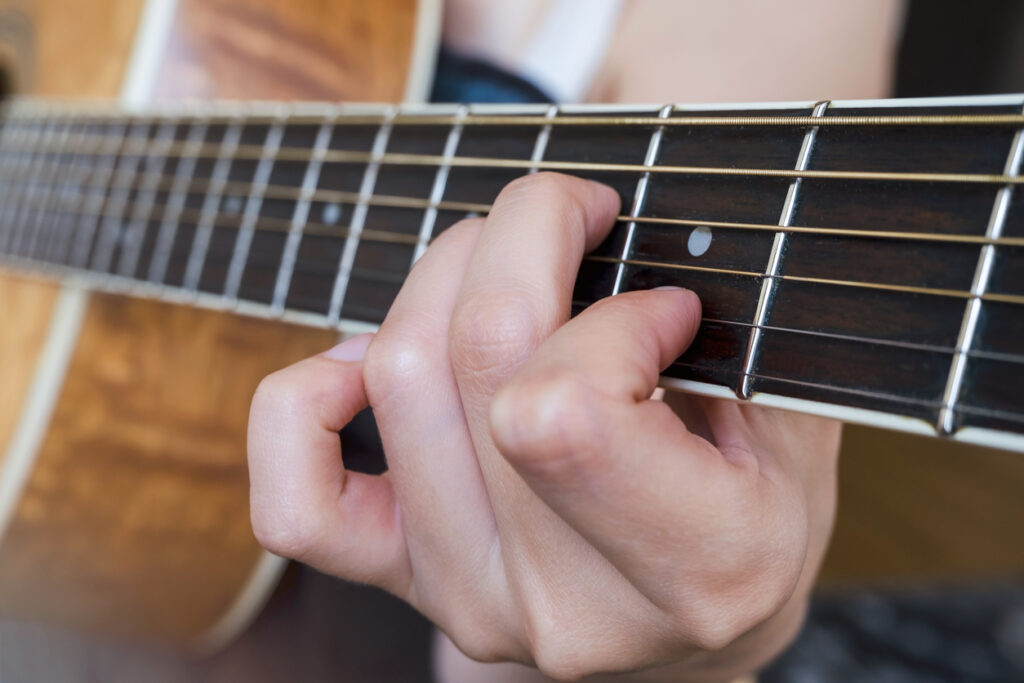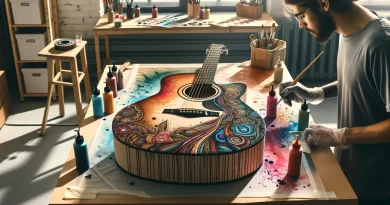Finger Exercises for Guitar: Enhance Dexterity & Speed

Finger exercises for guitar are essential for players aiming to boost their dexterity, speed, accuracy, and coordination. This guide delves into critical areas including basic finger exercises to set the foundation, finger independence exercises to enhance precision, finger strengthening exercises for greater endurance, finger stretching exercises for improved flexibility, and creative ways to perform finger exercises without a guitar for continuous skill enhancement. Each segment is designed to refine your abilities, ensuring your guitar playing becomes more seamless and expressive.
Basic rules in reading tab notation
Before we start flexing our fingers on the fretboard, let’s take a moment to revisit the basics of reading tab notation. It’s easy peasy once you get the hang of it, and then we’ll be ready to rock and roll!
Diagram Dissection: Unlocking the Fretboard
e|—-|—-|—-|—-|—-|—-|—-|—-|—-|—-|—-|—-|—-|—-|—-|—-|
B|—-|—-|—-|—-|—-|—-|—-|—-|—-|—-|—-|—-|—-|—-|—-|—-|
G|—-|—-|—-|—-|—-|—-|—-|—-|—-|—-|—-|—-|—-|—-|—-|—-|
D|—-|—-|—-|—-|—-|—-|—-|—-|—-|—-|—-|—-|—-|—-|—-|—-|
A|—-|—-|—-|—-|—-|—-|—-|—-|—-|—-|—-|—-|—-|—-|—-|—-|
E|—-|—-|—-|—-|—-|—-|—-|—-|—-|—-|—-|—-|—-|—-|—-|—-|
Your best friend in this guitar journey is going to be a simple diagram – the guitar fretboard. Picture it: six horizontal lines, each representing a string, intersecting with vertical lines, symbolizing frets.
Here’s where things can get a bit tricky for newcomers. The bottom line is actually your low E string, while the top line is your high e string. So from top to bottom, think e, B, G, D, A, E. It’s like learning a new language, but one that’s going to bring much more melody into your life!
Decoding the Numbers: Your Fretboard Map
You’ll start seeing numbers sprinkled across the fretboard diagram. Fear not, these numbers are your fretboard navigation system. A ‘1’ corresponds to the first fret, ‘2’ to the second fret, and so on up the neck of your guitar.
e|—-0—-|
B|—-1—-|
G|—-0—-|
D|—-2—-|
A|—-3—-|
E|———|
As you can see, the tab diagram shows you which fingers to use and where to place them on the fretboard. The numbers on the tab diagram correspond to the frets on the fretboard diagram. For example, the number 1 on the B string means you need to press the first fret on the B string.
Tab Symbols: The Guitar’s Secret Language
The tab notation is filled with symbols that represent various playing techniques. For instance, a ‘/’ symbol means slide up, while a ‘\’ symbol indicates slide down. And let’s not forget ‘h’ for hammer-on and ‘p’ for pull-off. These techniques are the spices in your music recipe, adding depth and nuance to your playing.
e|—————–|
B|—————–|
G|—————–|
D|—–5/7\5——-|
A|———7p5h7—|
E|-5h7————-|
As you can see, the tab diagram shows you how to play the notes and apply the techniques. The ‘/’ symbol means slide up from the 5th fret to the 7th fret on the D string. The ‘\’ symbol means slide down from the 7th fret to the 5th fret on the same string. The ‘h’ symbol means hammer-on from the 5th fret to the 7th fret on the A string. The ‘p’ symbol means pull-off from the 7th fret to the 5th fret on the same string. These techniques add depth and nuance to your playing, as they create smooth and legato sounds.
To help illustrate these techniques, here’s a nifty YouTube tutorial I found:
Strumming the Strings: Reading the Notes
e|—-1/2/3/4—-|
B|—————|
G|—————|
D|—————|
A|—————|
E|—————|
Now, let’s get those fingers moving! Reading the notes is as simple as reading a book – from left to right. So, if you see ‘1/2/3/4’, you’ll play the first fret, slide up to the second, continue to the third, and then slide up to the fourth. Boom! You’ve just played your first sequence!
If you want to learn more, check out this video on how to read guitar tab notations.
The Importance of Warming Up: Let the Dance Begin!
Just like athletes stretch before a game, guitarists need to warm up their fingers, hands, and wrists before shredding. Warming up increases blood flow to your fingers, prepping your muscles and joints for the symphony to come. Plus, it’s a great way to prevent injury and improve your technique, speed, accuracy, and coordination.
Finger Exercise Tips: Slow and Steady Wins the Race!
Finger exercises are not about speed, they’re about consistency and precision. Here are some quick tips to keep in mind:
- Embrace the metronome: This handy tool helps you develop your timing, rhythm, and consistency. Let the beat guide your fingers.
- Ease into it: Remember, guitar skills aren’t built overnight. Start slow to prevent mistakes and bad habits.
- Gradually up the ante: As you progress, gradually increase the difficulty of your exercises. This way, you’ll continue to challenge yourself and see faster progress.
Basic Finger Exercises: Time to Get Your Fingers Grooving!
Now that we’re all warmed up and ready to go, let’s dive into some basic finger exercises:
Exercise 1: Chromatic Scale
Think of the chromatic scale as your finger gym. It involves playing four notes per string, starting from the first fret and moving up one fret at a time. This exercise helps develop finger strength, independence, and reach.
e|—————————– —-1-2-3-4-|
B|————————-1-2-3-4———|
G|—— – ———-1-2-3-4—————–|
D|———1-2-3-4————————-|
A|-1-2-3-4—— —————————|
E|—————————————–|
Exercise 2: Spider Walk
Despite its creepy-crawly name, the spider walk is an exercise that involves playing two notes per string, alternating between the first and fourth fingers, while moving across the strings diagonally. It’s a great way to develop finger coordination and stretch.
e|—————–1-4-|
B|————-1-4—–|
G|———1-4———|
D|—–1-4————-|
A|-1-4—————–|
E|———————|
Exercise 3: String Skipping
String skipping is like a high-intensity interval training (HIIT) workout for your fingers. It involves playing four notes per string, skipping one string at a time, and moving up and down the fretboard. This exercise helps improve your string skipping accuracy and speed.
e|———————————1-2-3-4-|
B|—————————————–|
G|—————–1-2-3-4—————–|
D|—————————————–|
A|-1-2-3-4———————————|
E|—————————————–|
e|—————————————–|
B|—————–1-2-3-4—————–|
G|—————————————–|
D|———1-2-3-4————————-|
A|—————————————–|
E|-1-2-3-4———————————|
Exercise 4: Hammer-Ons and Pull-Offs
No need for an actual hammer here, just your fingers! This exercise involves playing four notes per string, using hammer-ons and pull-offs to create a smooth, flowing sound. It’s a wonderful way to develop your legato technique, finger strength, and overall smoothness.
e|———————————1h2p1h3p1h4p1-|
B|————————-1h2p1h3p1h4p1———|
G|—————–1 h2p1h3p1h4p1—————–|
D|———1h2p1h3p1h4p1————————-|
A|-1h2p1h3p1h4p1———————————|
E|———————————————–|
Exercise 5: Slides
Last but definitely not least, we have slides. This exercise involves playing four notes per string, using slides to smoothly transition between notes. It’s an excellent way to develop your slide technique, finger control, and expressive playing style.
e|———————————1/2/3/4-|
B|————————-1/2/3/4———|
G|—————–1/2/3/4—————–|
D|———1/2/3/4————————-|
A|-1/2/3/4———————— ———|
E|—————————————–|
Unlocking Finger Independence: Your Power Play to Mastering the Guitar

As a guitar player, you’ll quickly realize that finger independence is a game-changer. It’s like being a maestro, directing an orchestra where each player knows their part and performs it flawlessly. In the realm of guitar playing, having independent fingers allows you to navigate complex chords, melodies, and solos with ease and precision.
Decoding Finger Independence
Finger independence – it may sound like a term conjured up in a guitar maestro’s lab, but it’s a critical aspect of your guitar-playing arsenal. Here’s why:
- Swift and Smooth: Think about typing on a keyboard. If your fingers keep stumbling and missing keys, it’s frustrating, right? The same principle applies to the guitar fretboard. Independent fingers mean you play faster and smoother. It’s like having a well-oiled machine at your fingertips.
- Efficiency: Independence equates to efficiency. With each finger knowing its role, you eliminate wasted energy and unnecessary movements. This boosts your stamina for those epic jamming sessions where you lose track of time.
- Tension Release: Independent fingers can perform their tasks without causing tension in your hand and arm. This not only reduces the risk of injury but also ensures your playing remains relaxed and fluid, letting the music flow naturally.
Cultivating Your Finger Independence
So, how do you acquire this game-changing skill? Here are some tried-and-true tips:
- Practice at a Leisurely Pace: Start slow, focusing on each finger’s movement, position, and pressure. Think of it like learning to salsa – you need to master each step before you can dance fluidly.
- Make Friends with a Metronome: A metronome is your rhythmic ally. It keeps you in sync, encourages consistency, and nudges you to gradually increase your tempo.
- Mix Up Your Exercises: Diversify your exercises to keep things interesting. This strategy helps you dodge boredom and complacency, and exposes your fingers to a variety of patterns and challenges.
10 Finger Independence Exercises to Boost Your Skills
Let’s get practical with some exercises designed to fast-track your finger independence. Each exercise is tailored to challenge your fingers in different ways, transforming them into a well-coordinated and independent team.
*Note: For all exercises, start on the low E string, move up to the high E string, then reverse. Use alternate picking (down-up-down-up) throughout.*
1-2-3-4 Pattern
e|———————————1-2-3-4-|
B|————————-1-2-3-4———|
G|—————–1-2-3-4—————–|
D|———1-2-3-4————————-|
A|-1-2-3-4———————————|
E|—————————————–|
This is your basic climbing exercise. Play four notes per string, using your 1st, 2nd, 3rd, and 4th fingers in order. It’s like a fitness routine for your fingers, developing strength, coordination, and independence.
1-3-2-4 Pattern
e|———————————1-3-2-4-|
B|————————-1-3-2-4———|
G|—————–1-3-2-4—————–|
D|———1-3-2-4————————-|
A|-1-3-2-4———————————|
E|—————————————–|
This exercise mixes things up a bit. You’ll use the 1st, 3rd, 2nd, and 4th fingers in order, which helps build independence, stretch, and synchronization.
1-4-2-3 Pattern
e|———————————1-4-2-3-|
B|————————-1-4-2-3———|
G|—————–1-4-2-3—————–|
D|———1-4-2-3————————-|
A|-1-4-2-3———————————|
E|—————————————–|
Ready for a challenge? Here, you’ll use the 1st, 4th, 2nd, and 3rd fingers in order. This is great for stretching out those fingers and working on synchronization.
1-2-4-3 Pattern
e|———————————1-2-4-3-|
B|————————-1-2-4-3———|
G|—————–1-2-4-3—————–|
D|———1-2-4-3————————-|
A|-1-2-4-3———————————|
E|—————————————–|
Keep the challenge going with this exercise. Use the 1st, 2nd, 4th, and 3rd fingers in order. Pay close attention to your finger positioning and control.
1-3-4-2 Pattern
e|———————————1-3-4-2-|
B|————————-1-3-4-2———|
G|—————–1-3-4-2—————–|
D|———1-3-4-2————————-|
A|-1-3-4-2———————————|
E|—————————————–|
This pattern might feel a little strange at first, but it’s excellent for working on finger independence and stretch.
1-4-3-2 Pattern
e|———————————1-4-3-2-|
B|————————-1-4-3-2———|
G|—————–1-4-3-2—————–|
D|———1-4-3-2————————-|
A|-1-4-3-2———————————|
E|—————————————–|
Another demanding exercise, using the 1st, 4th, 3rd, and 2nd fingers in order. This one will definitely test your fingers’ independence.
2-1-3-4 Pattern
e|———————————2-1-3-4-|
B|————————-2-1-3-4———|
G|—————–2-1-3-4—————–|
D|———2-1-3-4————————-|
A|-2-1-3-4———————————|
E|—————————————–|
Starting with the 2nd finger, this pattern gives your fingers a different challenge, and helps to develop your finger independence and synchronization.
2-3-1-4 Pattern
e|———————————2-3-1-4-|
B|————————-2-3-1-4———|
G|—————–2-3-1-4—————–|
D|———2-3-1-4————————-|
A|-2-3-1-4———————————|
E|—————————————–|
This pattern also starts with the 2nd finger but changes the order to 2nd, 3rd, 1st, and 4th. Keep your focus on finger positioning and control.
2-4-1-3 Pattern
e|———————————2-4-1-3-|
B|————————-2-4-1-3———|
G|—————–2-4-1-3—————–|
D|———2-4-1-3————————-|
A|-2-4-1-3———————————|
E|—————————————–|
This exercise uses the 2nd, 4th, 1st, and 3rd fingers in order. It’s a great way to work on stretch and synchronization.
2-1-4-3 Pattern
e|———————————2-1-4-3-|
B|————————-2-1-4-3———|
G|—————–2-1-4-3—————–|
D|———2-1-4-3————————-|
A|-2-1-4-3———————————|
E|—————————————–|
Finally, use the 2nd, 1st, 4th, and 3rd fingers in order for this exercise. This one will give your fingers a real workout!
The Power of Finger-Strengthening Exercises
As guitarists, we understand the importance of finger strength – it’s the lifeblood of our craft. The stronger and more enduring your fingers, the more control you have over the strings. This control is the key to faster, louder, and longer playing.
But that’s not all. Finger-strengthening exercises also enhance your technique, accuracy, and expression. The more control you have, the more emotion you can infuse into each note, transforming simple chords into musical narratives.
Tools to Strengthen Your Fingers
So, how do we transform our fingers into rock-star-ready tools? While there’s no magic formula, here are a few proven methods:
- Finger Exerciser: Tools like the Grip Master are fabulous for training each finger individually. They can help to isolate each digit, providing a comprehensive workout for your hand.
- Grip Strengthener: Consider using a Hand Grip to boost the overall strength and stamina of your hand and forearm muscles. It’s essential to remember that your fingers aren’t solo performers – they’re part of an ensemble!
- Stress Ball: A stress ball is more than just a fun toy. Squeezing one can relieve tension and enhance blood circulation in your hand and fingers. Plus, it’s a nice break from the strumming and plucking routine.
Four Finger-Strengthening Exercises for Power Play
Now that we’ve covered the tools, let’s get into some specific exercises. These are simple, can be done anywhere, and are guaranteed to give your fingers a good workout:
- Finger Push-Ups: Plant your fingers on a flat surface, and push down as hard as you can. This exercise is great for strengthening those often overlooked 3rd and 4th fingers.
- Finger Lifts: With your hand flat on a surface, lift each finger as high as possible, one at a time. This exercise promotes strength, flexibility, and independence.
- Finger Squeezes: Got coins or guitar picks? Place one between two fingers and squeeze. This exercise develops strength, coordination, and balance.
- Finger Stretches: Stretch your fingers in different directions. The more you stretch, the more you’ll improve your finger strength, flexibility, and range of motion.
Why Stretching Matters to Guitarists

As guitarists, we’re akin to athletes, each jam session is a big game that requires a warm-up. Stretching our fingers, wrists, and arms can have a profound impact on our performance. Not only does it ward off stiffness and potential injury, but it also enhances our flexibility, range of motion, and circulation. So, let’s delve into the world of guitar fitness and explore some stretching exercises to keep your fingers agile and ready to strum.
The Art of Stretching
Musicians, especially guitarists, are at risk of repetitive strain injuries. However, a few simple stretching techniques can dramatically reduce that risk. Here are some tips for your stretching routine:
Gentle approach: Treat your hand like a finely-tuned instrument – no quick or forced movements.
Duration: Each stretch should last 10-15 seconds, allowing muscles and tendons enough time to relax and elongate.
Breathing: Deep breaths can help oxygenate your blood and release tension, and it’s a great way to calm pre-performance jitters too!
Now that we’ve covered the basics, let’s deep dive into some specific exercises.
Exercise 1: Wrist Flexion and Extension
The first exercise focuses on the wrist. With your fingers straight and relaxed, slowly flex and extend your wrist. This stretches the muscles in your wrist, forearm, and fingers, vital for those complicated chords.
Exercise 2: Wrist Rotation
Next up, wrist rotations. Keep your fingers straight and relaxed while rotating your wrist clockwise, then counterclockwise. This exercise targets the same muscles as the previous one but provides a different angle, adding some spice to your routine.
Exercise 3: Finger Spread
This exercise, the finger spread, is my personal favorite. Spread your fingers as wide as possible, then clasp them together. This simple yet effective move stretches your hand and palm muscles, crucial for a robust fretting hand.
Exercise 4: Finger Flexion and Extension
Lastly, we have finger flexion and extension. With your wrist straight and relaxed, bend your fingers forward and backward. This exercise hones in on your fingers and hands, perfect for enhancing dexterity.
Practice Makes Perfect
Like mastering a complex solo, these exercises will require consistent practice. However, stick with them, and you’ll notice a difference in your playing. Remember, a relaxed hand equates to a faster hand. So, before your next jam session, try these exercises out. Your hands will thank you!
Finger Exercises Without a Guitar: Keep Your Fingers Nimble Anywhere, Anytime!
Here’s a little secret about mastering the guitar: It isn’t just about the time spent with the instrument in your hands. It’s also about nurturing your finger strength, dexterity, and coordination even when you’re away from your beloved six-string. Here are some benefits of practicing finger exercises without your guitar:
Practice Anywhere, Anytime: Now, you can keep your fingers limber while on the bus, waiting for your coffee, or during those pesky commercial breaks.
Stealth Mode On: These silent exercises won’t disturb those around you while you’re covertly improving your guitar skills.
Get Creative: Guitar-Free Finger Exercise Tips
Now, let’s explore some practical tips on how to do finger exercises without a guitar.
Everyday Objects Are Your New Best Friends: Pens, coins, stress balls – these everyday items can now provide the resistance needed to strengthen your fingers.
Air-Guitar Movements: Mimic fretting, picking, or strumming movements to enhance muscle memory, technique, and coordination.
Mind Over Matter: Visualize the fretboard, the notes, chords, or scales. This mental exercise can boost your ear training and creativity.
Top 5 Finger Exercises Without a Guitar
Inspired by a Reddit thread, here are some finger exercises you can do anywhere and anytime to keep your fingers limber and ready for some guitar action.
- Two-Legged Walk: Walk your fingers on a flat surface, using your middle and ring fingers as ‘legs’, while the index and pinky act like arms. This exercise improves finger independence, coordination, and balance.
- Devil Walk: Use the heavy-metal horns gesture as a finger exercise. The index finger and pinky act as ‘legs’, enhancing your finger stretch and synchronization.
- Crutch Walk: Use your thumb and pinky as ‘crutches’ while walking the other fingers. This exercise develops finger strength, independence, and coordination.
- Finger Tapping: Tap your fingers on a flat surface in various patterns and rhythms. Consider it a mini drum solo for your fingers, improving speed, accuracy, and timing.
- Finger Spelling: Try spelling words using the American Sign Language alphabet. Not only does it boost finger flexibility and memory, but it’s also a fun party trick!
Remember, these exercises are just as important as your daily practice sessions. So, keep your fingers nimble, and let’s rock on!
Conclusion
In conclusion, this article has highlighted the indispensable role of finger exercises for guitar in elevating a player’s technique and musicianship. Through the practice of basic finger exercises, finger independence drills, strengthening routines, stretching movements, and exercises without a guitar, players can significantly improve their dexterity, speed, accuracy, and coordination. The benefits of these exercises extend beyond mere technical proficiency, fostering a deeper connection with the instrument and enhancing musical expression.
To truly reap the rewards of these exercises, consistency is key. Regular practice not only solidifies the skills but also integrates them into your playing, making complex pieces more accessible and performance more fluid. For those eager to dive deeper into their guitar journey, guitarsongsmasters.com offers a treasure trove of resources, tips, and lessons designed to further your development as a guitarist.
We encourage you to take this knowledge, apply it diligently, and explore the vast resources available. Share your feedback, questions, or suggestions in the comments section below. Your insights and experiences are valuable to us and the guitar-playing community. Let’s continue to grow together, one finger exercise at a time.
Originally posted by Alon Cooper at https://guitarsongsmasters.com/finger-exercises-for-guitar/



